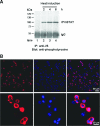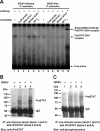White spot syndrome virus annexes a shrimp STAT to enhance expression of the immediate-early gene ie1
- PMID: 17079306
- PMCID: PMC1797513
- DOI: 10.1128/JVI.01880-06
White spot syndrome virus annexes a shrimp STAT to enhance expression of the immediate-early gene ie1
Abstract
Although the Janus kinase-signal transducer and activator of transcription (JAK-STAT) signaling pathway is part of the antiviral response in arthropods such as Drosophila, here we show that white spot syndrome virus (WSSV) uses a shrimp STAT as a transcription factor to enhance viral gene expression in host cells. In a series of deletion and mutation assays using the WSSV immediate-early gene ie1 promoter, which is active in shrimp cells and also in insect Sf9 cells, an element containing a STAT binding motif was shown to be important for the overall level of WSSV ie1 promoter activity. In the Sf9 insect cell line, a specific protein-DNA complex was detected by using electrophoresis mobility shift assays (EMSA) with the 32P-labeled STAT binding motif of the WSSV ie1 promoter as the probe. When recombinant Penaeus monodon STAT (rPmSTAT) was overexpressed in Sf9 cells, EMSA with specific antibodies confirmed that the STAT was responsible for the formation of the specific protein-DNA complex. Another EMSA showed that in WSSV-infected P. monodon, levels of activated PmSTAT were higher than in WSSV-free P. monodon. A transactivation assay of the WSSV ie1 promoter demonstrated that increasing the level of rPmSTAT led to dose-dependent increases in ie1 promoter activity. These results show that STAT directly transactivates WSSV ie1 gene expression and contributes to its high promoter activity. We conclude that WSSV successfully annexes a putative shrimp defense mechanism, which it uses to enhance the expression of viral immediate-early genes.
Figures









Similar articles
-
Role of Litopenaeus vannamei Yin Yang 1 in the Regulation of the White Spot Syndrome Virus Immediate Early Gene ie1.J Virol. 2017 Feb 28;91(6):e02314-16. doi: 10.1128/JVI.02314-16. Print 2017 Mar 15. J Virol. 2017. PMID: 28077637 Free PMC article.
-
The promoter of the white spot syndrome virus immediate-early gene WSSV108 is activated by the cellular KLF transcription factor.Dev Comp Immunol. 2015 Mar;49(1):7-18. doi: 10.1016/j.dci.2014.10.015. Epub 2014 Nov 6. Dev Comp Immunol. 2015. PMID: 25445906
-
Shrimp NF-κB binds to the immediate-early gene ie1 promoter of white spot syndrome virus and upregulates its activity.Virology. 2010 Oct 25;406(2):176-80. doi: 10.1016/j.virol.2010.06.046. Epub 2010 Aug 3. Virology. 2010. PMID: 20684968
-
Evolution of specific immunity in shrimp - a vaccination perspective against white spot syndrome virus.Dev Comp Immunol. 2014 Oct;46(2):279-90. doi: 10.1016/j.dci.2014.04.013. Epub 2014 Apr 26. Dev Comp Immunol. 2014. PMID: 24780624 Review.
-
Ophiopogon japonicus inhibits white spot syndrome virus proliferation in vivo and enhances immune response in Chinese mitten crab Eriocheir sinensis.Fish Shellfish Immunol. 2021 Dec;119:432-441. doi: 10.1016/j.fsi.2021.10.028. Epub 2021 Oct 21. Fish Shellfish Immunol. 2021. PMID: 34688864 Review.
Cited by
-
The shrimp IKK-NF-κB signaling pathway regulates antimicrobial peptide expression and may be subverted by white spot syndrome virus to facilitate viral gene expression.Cell Mol Immunol. 2013 Sep;10(5):423-36. doi: 10.1038/cmi.2013.30. Epub 2013 Aug 19. Cell Mol Immunol. 2013. PMID: 23954949 Free PMC article.
-
MAP3K15 facilitates multiple viral genes expression in crustaceans via Dorsal-CC-CL-STAT axis besides the JNK/P38 pathway.PLoS Pathog. 2025 Aug 1;21(8):e1013349. doi: 10.1371/journal.ppat.1013349. eCollection 2025 Aug. PLoS Pathog. 2025. PMID: 40749022 Free PMC article.
-
Penaeus monodon thioredoxin restores the DNA binding activity of oxidized white spot syndrome virus IE1.Antioxid Redox Signal. 2012 Sep 15;17(6):914-26. doi: 10.1089/ars.2011.4264. Epub 2012 Apr 16. Antioxid Redox Signal. 2012. PMID: 22332765 Free PMC article.
-
Microarray analyses of shrimp immune responses.Mar Biotechnol (NY). 2011 Aug;13(4):629-38. doi: 10.1007/s10126-010-9291-1. Mar Biotechnol (NY). 2011. PMID: 20393773 Review.
-
Laminin Receptor in Shrimp Is a Cellular Attachment Receptor for White Spot Syndrome Virus.PLoS One. 2016 Jun 3;11(6):e0156375. doi: 10.1371/journal.pone.0156375. eCollection 2016. PLoS One. 2016. PMID: 27257954 Free PMC article.
References
-
- Agaisse, H., and N. Perrimon. 2004. The roles of JAK/STAT signaling in Drosophila immune responses. Immunol. Rev. 198:72-82. - PubMed
-
- Agaisse, H., U. M. Petersen, M. Boutros, B. Mathey-Prevot, and N. Perrimon. 2003. Signaling role of hemocytes in Drosophila JAK/STAT-dependent response to septic injury. Dev. Cell. 5:441-450. - PubMed
-
- Akira, S., Y. Nishio, M. Inoue, X. J. Wang, S. Wei, T. Matsusaka, K. Yoshida, T. Sudo, M. Naruto, and T. Kishimoto. 1994. Molecular cloning of APRF, a novel IFN-stimulated gene factor 3 p91-related transcription factor involved in the gp130-mediated signaling pathway. Cell 77:63-71. - PubMed
Publication types
MeSH terms
Substances
LinkOut - more resources
Full Text Sources
Other Literature Sources

